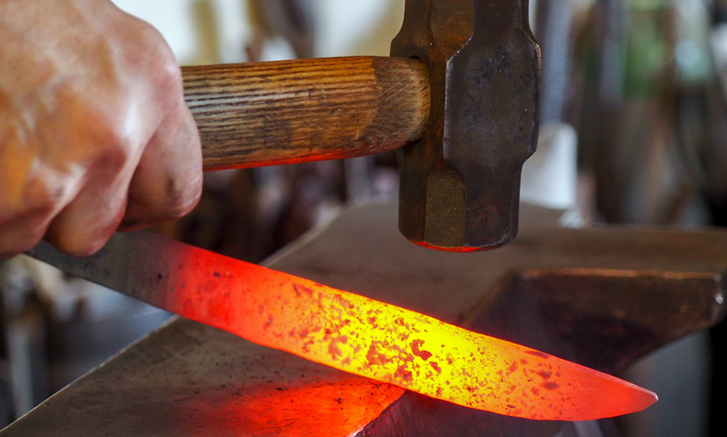Intro to Knife Steel:
Throughout the ages, knives have been used as tools that aid whoever uses them to make tasks easier, and just as humanity has adapted over the years, so have their knives and tools. The first knives were made of flint that early humans would strike to make a fine point and a thin edge, but since they were made of flint, they were often too brittle for long-term use. As humanity moved from stone to bronze and bronze to iron, knives and other tools would be made of different materials to serve better in their specific purpose.
Now onto today, knives are made from steel and sometimes even ceramic. Over the years, as the knife community has grown and changed, many people have used metallurgical engineering to optimize steel to fit their various needs. This has led to a divide of steels into different categories, mainly high carbon and stainless. We will also talk about some other sub-categories, such as tool steel, semi-stainless, spring steel, and high-speed steel.
Knife Steel Properties:
These different types of steel have different properties and uses depending on how they perform different tasks. The first things to go over are the main categories of steel properties and what they mean to the performance of the knife.
- Corrosion resistance: As the name implies, this category is about how well the steel resists rusting/corrosion. Knives with a high corrosion resistance are typically used when you are in high humidity areas, or near water and salt, like when diving. It is important to keep in mind that when knife steels have increased corrosion resistance, they tend to sacrifice edge retention.
- Edge retention: How well the knife, after being sharpened properly, will keep its edge. Edge retention doesn’t have a set measurement standard, so it can be hard to gauge. It is often quantified by a knife’s ability to resist wear and deformation.
- Grindability/Ease of sharpening: How easy it is to remove material from steel, typically by the use of abrasive materials.
- Toughness/Durability: How well a knife can take a beating while not retaining lasting damage or deforming.
- Hardness: How hard the steel is, which is typically measured on a Rockwell scale. This can be an indicator of the edge retention of the steel, as well as its toughness. Harder steel is typically better at keeping an edge but more brittle. This property can be tied to toughness and edge retention, as steels have different properties at different hardness levels.
- Wear Resistance: The Steels ability to withstand wear from both abrasion and adhesion. This is typically tied with edge retention.
There are many ways to affect each category when making the knife, from the composition of the steel and what method was used to manufacture it, the grind of the blade, as well as the quenching and tempering process, will all affect the end product. Even if you have the “perfect knife steel” that offers the best performance in every category, if it isn’t ground and hardened properly, it would all be meaningless.
Knife Steel Alloys:
When it comes to the actual composition of the metal, there are many alloys used in varying quantities to allow for different qualities to be shown in the metal after finishing a blade.
The qualities added by the alloys are as follows:
- Boron (B): Increases the steel’s strength and hardenability.
- Lead (Pb): Mainly used to increase steel machinability.
- Zirconium (Zr): Mainly used to increase ductility and hardness.
- Carbon (C): Mainly used to increase hardness but lowers corrosion resistance.
- Chromium (Cr): Mainly used to increase corrosion resistance and wear resistance.
- Cobalt (Co): Mainly used to increase the red hardness of high-speed steel.
- Copper (Cu): Mainly used to improve corrosion resistance, but can also make the steel harder to forge at high temperatures. Another interesting feature is that it can increase the antibacterial properties of the steel.
- Molybdenum (Mo): Mainly used to increase wear resistance by forming carbides and slightly increasing hardness and corrosion resistance.
- Manganese (Mn): Increases hardenability, toughness, and wear resistance.
- Vanadium (V): Mainly used to form carbides, increasing wear resistance and hardenability.
- Nitrogen (N): Increases hardness, similar to carbon, but doesn’t reduce corrosion resistance. It isn’t as commonly used as it is difficult to achieve significant levels of Nitrogen in steel.
- Nickel (Ni): It adds toughness, reduces hardness, and improves corrosion and heat resistance. Adding too much Nickel can make the steel unable to harden in heat treating.
- Niobium (Nb): Restricts carbide grain growth, and increases carbide hardness and machinability. It is also known to increase the strength of the metal, corrosion and heat resistance, and overall toughness.
- Phosphorus (P): Improves strength, machinability, and hardness but can make the steel brittle in high concentrations.
- Sulfur (S): Helps to prevent pitting corrosion by forming sulfide inclusions.
- Silicon (Si): Increases the steel’s strength, machinability, and hardness.
- Tantalum (Ta): Increases overall corrosion and heat resistance, strength, ductility, and toughness.
- Titanium (Ti): Titanium increases strength, toughness, heat, and corrosion resistance and reduces weight. It can also increase hardness and wear resistance if nitrogen or carbon are at the surface of the alloy.
- Tungsten (W): Improves corrosion and heat resistance. Adds strength and toughness and improves hardenability. Tungsten also helps steel retain its hardness at high temperatures.
Now that you have an idea of how each material affects the properties of steel, it’s time to explain how you choose what steel you should look for in your next knife.
When looking at knife steel, it is important to know what you will be using the knife for and what the most desirable properties to have would be. For example, if you are looking for a bush crafting knife to last a lifetime without breaking, then you would want to look into high carbon steels that offer superior toughness and strength while avoiding high-speed steels which offer high edge retention while significantly lowering toughness.
High carbon steel is typically used in harder use tools like bush crafting and any hard use tasks that require high strength and durability. These knives perform well in heavy-duty tasks, but typically have a low corrosion resistance due to the high volume of carbon. Some people refer to these as ten series steels, since most high carbon steel starts with a ten, such as 1050, 1060, 1070, and so on.
- Stainless steel is typically used for either daily use tasks or precision tasks. These knives tend to have higher corrosion resistance due to an increased amount of chromium. They also tend to have more variety in their properties as many companies use stainless steel in almost every industry, so there are quite a few people constantly working to make more advanced steel.
- Tool Steel is typically higher carbon steel, not associated with the ten series, that is used in hand tools, dies, and knives. Tool Steel is typically categorized by its high hardness and durability, using tungsten, chromium, vanadium, and molybdenum as its main alloying elements while having a low amount of manganese to minimize the possibility of it cracking during heat treatment.
- High-Speed Steel is typically used in high-speed applications like power saw blades and drill bits. It can withstand higher temperatures while keeping its temper, which allows the steel to cut faster than conventional high carbon steel. At room temperature, they display high hardness and wear resistance.
- Spring Steel is usually used in, you guessed it, metal springs. They typically have a lower manganese content, medium carbon content, and high carbon content. This leads to the steel having a higher yield strength, giving it high durability and allowing it to return to its original form after bending.
- Semi-Stainless is categorized by having a higher carbon content but also has a higher chromium content than most carbon steel, wavering at the edge of being considered either carbon steel or stainless steel.
There are also CPM steels, which use Crucible Particle Metallurgy to produce steel with a more organized structure. This production method allows the steel to perform at its maximum potential, as long as it has an optimal heat treat and blade grind. CPM steels offer higher edge retention, and toughness than their non-CPM counterparts, with the only downside being that they can only be used in material removal knifemaking and not forging, since forging would compromise the structure made by the CPM process. These steels are only produced by American Crucible Industries.
Lastly, there is the famous Damascus steel; although Damascus Steel originates from the ancient civilizations in the middle east, the original formula for the Legendary material has been lost, and now all that is left is modern-day Damascus, which is made from pattern welding steel. Modern-day Damascus is used mainly for aesthetics or for collection pieces since it doesn’t guarantee the steel will perform higher in any regard and usually falls short when compared to other more optimized steels depending on its composition.


